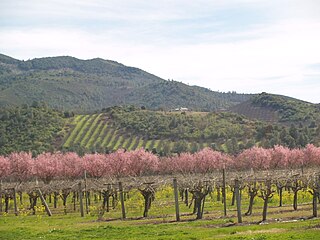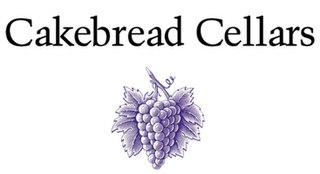
Concannon Vineyard is the second-largest winery in the Livermore Valley of California, producing around 30,000 cases annually. It is well known for its Petite Sirah and Concannon was the first winery to bottle this grape as a varietal wine in 1961. Prior to 1961, the petite sirah grape was produced worldwide as a blend wine. It also produces several other varieties of wine, including Chardonnay and Cabernet Sauvingnon. Concannon is owned by The Wine Group.

Heitz Cellar is a California wine producer located within Napa Valley east of the town of St. Helena. An early modern era Napa Valley presence and pioneering exponent of French oak, the estate enjoys a historical renown with the success of its Martha's Vineyard Cabernet Sauvignon, and has also been described as a "master of Grignolino".

Washington wine is a wine produced from grape varieties grown in the U.S. state of Washington. Washington ranks second in the United States in the production of wine. By 2017, the state had over 55,000 acres (220 km2) of vineyards, a harvest of 229,000 short tons (208,000 t) of grapes, and exports going to over 40 countries around the world from the 940+ wineries located in the state. While there are some viticultural activities in the cooler, wetter western half of the state, the majority (99.9%) of wine grape production takes place in the shrub-steppe eastern half. The rain shadow of the Cascade Range leaves the Columbia River Basin with around 8 inches (200 mm) of annual rain fall, making irrigation and water rights of paramount interest to the Washington wine industry. Viticulture in the state is also influenced by long sunlight hours and consistent temperatures.

Red Mountain is an American Viticultural Area (AVA) that encompasses the local region surrounding Red Mountain in Benton County, Washington. The viticultural area was formally recognized on June 11, 2001 by the Bureau of Alcohol, Tobacco and Firearms (ATF), Treasury after reviewing the petition submitted by Lorne Jacobson of Hedges Cellars to establish an area known as "Red Mountain." It lies entirely within the Yakima Valley and vast Columbia Valley appellations and is the smallest AVA in the state at only 4,040 acres (6.31 sq mi) in area and lies between Benton City and the City of West Richland. The area has more than 2,225 acres (900 ha) under cultivation of primarily red varietals including Cabernet Sauvignon, Merlot, Sangiovese, Cabernet Franc and Syrah. The reputation of the area's wines has brought Red Mountain worldwide attention and acclaim for producing some of the most desired Washington State vintage wines.

Walla Walla Valley is an American Viticultural Area (AVA) located within Washington state and extending partly into the northeastern corner of Oregon. The wine region is entirely included within the larger Columbia Valley AVA. In addition to grapes, the area produces sweet onions, wheat and strawberries After the Yakima Valley AVA, the Walla Walla AVA has the second highest concentration of vineyards and wineries in Washington State. Walla Walla hosts about 140 wineries. The area was recognized on March 7, 1984 by the Bureau of Alcohol, Tobacco and Firearms (ATF), Treasury after reviewing the petition submitted by Mr. Richard L Small, President of the Walla Walla Valley Winegrowers Association, for the establishment of a viticultural area in southeast Washington and northeast Oregon, east of Lake Wallula, to be known as "Walls Walls Valley." At the time, Walla Walla Valley viticultural area was approximately 178,560 acres (279 sq mi) with two bonded wineries and about 60 acres (24 ha) from several vineyards.

Horse Heaven Hills is an American Viticultural Area (AVA) in southeastern Washington lying in portions of Klickitat, Yakima, and Benton counties, north and west of the Columbia River and south of the Yakima Valley and lies within the vast Columbia Valley appellation. Horse Heaven Hills was established by the Alcohol and Tobacco Tax and Trade Bureau {TTB), Treasury on June 30, 2005 after reviewing the petition filed by Paul D. Lucas on behalf of regional wine grape growers. Horse Heaven Hills viticultural area is about 60 miles (97 km) long and 22 miles (35 km) wide located 115 miles (185 km) east from Vancouver, Washington. The appellation encompasses 570,000 acres (891 sq mi) with about 6,400 acres (2,590 ha) under vine.

Napa Valley is an American Viticultural Area (AVA) located in Napa County, California. It was established by the Bureau of Alcohol, Tobacco and Firearms (ATF) on January 27, 1981. Napa Valley is considered one of the premier wine regions in the world. Records of commercial wine production in the region date back to the nineteenth century, but premium wine production dates back only to the 1960s.
Guenoc Valley is an American Viticultural Area in Lake County, California, United States, about 15 mi (24 km) north of the town of Calistoga. Guenoc Valley AVA was the first American Viticultural Area designation granted to an area with just a single winery.

The Mendocino County wine is an appellation that designates wine made from grapes grown mostly in Mendocino County, California. The region is part of the larger North Coast AVA and one of California's largest and most climatically diverse wine growing regions. Mendocino County is one of the northernmost commercial wine grape regions in the state with two distinct climate zones separated by the Mendocino Range. Ten American Viticultural Areas have been designated within Mendocino County. Mendocino is one of the leading wine growing regions for organically produced wine grapes. Nearly 25% of the acreage in Mendocino County is grown organically. In 2004, the residents of the county voted to become the first GMO-free county in the United States in an initiative that was supported by many of the county's largest wineries. The county's widespread focus on organic viticulture has inspired journalists to describe it as "California's organic wine Mecca".

Sonoma County wine is wine made in Sonoma County, California, in the United States.

Santa Cruz Mountains AVA is an American Viticultural Area (AVA) centered on the Santa Cruz Mountains. Its territory spans three California counties, Santa Clara, Santa Cruz and San Mateo and was established January 4, 1982 by the Bureau of Alcohol, Tobacco and Firearms (ATF), Treasury. Santa Cruz Mountains AVA was among the first AVA to be defined by its mountainous topography. Based on elevation, it largely follows the fog line along the coast, extending down to 800 feet (240 m) on the eastern slope toward San Francisco Bay, 400 feet (120 m) on the western slope to the Pacific Ocean and extending along the ridge crest line at 3,000 feet (910 m) elevation plus.

The Oakville AVA is an American Viticultural Area located within Napa Valley AVA and centered on the town of Oakville, California. The appellation extends over a flat expanse of well-drained gravel soil between the Vaca and Mayacamas Mountains. Oakville AVA is known for its success with Bordeaux varietals, which have produced wines of rich texture, firm tannins, and notes of mint and herbs.

The Stags Leap District AVA is an American Viticultural Area located within the Napa Valley AVA 6 miles (9.7 km) north of the city of Napa, California. The Stags Leap District was the first appellation to be designated an AVA based on the unique terroir characteristics of its soil. The soil of this region include loam and clay sediments from the Napa River and volcanic soil deposits left over from erosion of the Vaca Mountains. Like many Napa Valley AVAs, Stags Leap District is particularly known for its Cabernet Sauvignon. In 1976 at the Judgment of Paris wine tasting, the 1973 Stag's Leap Wine Cellars Cabernet from the area that would become this AVA won first place in the red wine category, beating out classified Bordeaux estates. Today, the Stags Leap District is home to twenty different wineries.
The Oak Knoll District of Napa Valley AVA is an American Viticultural Area located within Napa Valley AVA at the southern end of the valley floor. The appellation's close proximity to San Pablo Bay results in a climate that is cooler and more moderate than any region in Napa Valley other than the Los Carneros AVA. The AVA has more vines planted to it than any other wholly contained appellation within the Napa Valley. A wide variety of wine grapes do well in this climate, including varieties not widely grown in other parts of Napa Valley, such as Riesling and Pinot noir. The district is planted largely to Merlot, Chardonnay and Cabernet Sauvignon, in that order. Oak Knoll District Chardonnay has a reputation for a restrained, delicate style. The appellation was officially designated an appellation within the Napa Valley AVA on April 26, 2004.
The Chiles Valley is an American Viticultural Area (AVA) located in Napa County, California and a sub-region within Napa Valley AVA. It was established as California's 81st AVA by the Bureau of Alcohol, Tobacco and Firearms (ATF) on April 19, 1999 after the ATF received the petition from Mr. Volker Eisele, owner of the Volker Eisele Vineyard and Winery proposing a new viticultural area in Napa County to be known as "Chiles Valley District".

The Spring Mountain District AVA is an American Viticultural Area located in the Napa Valley AVA in California. Spring Mountain District AVA was officially established as an American Viticulture Area in 1993. Encompassed within its bounds are about 8,600 acres (3,480 ha), of which about 1,000 acres (400 ha) are planted to vineyards. Given the small crop yields on hillsides, the region represents less than 2% of Napa Valley wine. Currently the region has just over 30 winegrowers.

Colorado wine refers to wine made from grapes grown in the U.S. state of Colorado. Most of Colorado's vineyards are located on the western slope of the Rocky Mountains, though an increasing number of wineries are located along the Front Range.

California wine production has a rich viticulture history since 1680 when Spanish Jesuit missionaries planted Vitis vinifera vines native to the Mediterranean region in their established missions to produce wine for religious services. In the 1770s, Spanish missionaries continued the practice under the direction of the Father Junípero Serra who planted California's first vineyard at Mission San Juan Capistrano.

Lake County wine is an appellation that designates wine made from grapes grown mostly in Lake County, California. The region is located north of Napa County and east of Mendocino County. Although each region within Lake County has unique viticultural attributes, many are influenced by Clear Lake, the largest inland body of water in California.

Cakebread Cellars is a Napa Valley winery known for its Chardonnay and Sauvignon Blanc wines, which are internationally distributed. Founded in 1973 by Jack and Dolores Cakebread in Rutherford, California, the winery produces approximately 200,000 cases of wine per year.























